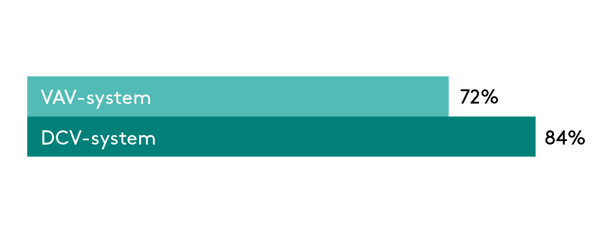In our previous post we talked about DCV and why DCV is a smart investment in residential buildings. So, you may have heard about both VAV and DCV and wondered what the difference actually is. We review the terms and when you are best-served by going for one or the other.
VAV and DCV systems essentially serve the same purpose: adjusting the ventilation and air conditioning in response to varying activity levels in our premises. Generally speaking, you stand to gain higher energy-efficiency and a better indoor climate the more advanced your system is. Of course, there are also applications where the more basic systems work perfectly.
There are a number of acronyms for the different types of ventilation control systems, but the three you are most likely to come across are:
CAV – Constant Air Volume
VAV – Variable Air Volume
DCV – Demand Controlled Ventilation
So, what are the differences and advantages of these three options?
VAV
- The most basic demand control - allows the air flow to be varied during service hours and can be adjusted in response to factors such as temperature or air quality
- Typically the up-front cost of this type of system is lower for a small-scale project, as compared with DCV
- Typically meets the requirements specifications for less complex projects such as preschools and small schools
- Typically offers meaningful energy savings as compared with CAV
DCV
- Advanced demand control - adjusts the air flow and temperature in response to demand and occupancy status in rooms to cater for differing uses
- Offers more options for fine-tuning the comfort level to cater for differentiated occupant requirements
- Typically offers the option of combining airborne and waterborne products for a full-service indoor climate system
- Will be a key criterion for achieving exemplary classification under various certification programmes such as BREEAM, WELL and LEED
- Extended options for achieving energy-efficiencies, which is a significant advantage in buildings with high energy expenditure on ventilation and air conditioning
With both of these options, you stand to both reduce your energy consumption and improve your indoor climate as compared with CAV. A comparison of air flow (m3/h) depending on the occupancy rate in a given space revealed that a basic on/off VAV system was able to reduce flow by 72% and a DCV system by as much as 84% as compared with a CAV system.
A comparison of air flow (m3/h) depending on the occupancy rate in a given space revealed that a basic on/off VAV system was able to reduce flow by 72% and a DCV system by as much as 84% as compared with a CAV system.

This means that a basic VAV system may be perfectly adequate for small-scale projects, where the demand scenario is less advanced but where the investment cost is a critical factor. For projects where the indoor climate requirements are more stringent and the building is likely to need to be environmentally certified, you’ll be looking for a more advanced DCV system. One advantage of DCV systems is that they come with a wide range of features to cater for the type of intelligent buildings that are becoming increasingly common such as the world’s greenest building, The Edge, in Amsterdam. Studies reveal that a better indoor climate increases the value of the building and also the wellbeing and productivity of people present inside them.
For more information, get in touch with your local Swegon contact or visit Swegon.com
You might recognize this post. It was previously posted on our Swedish blog: Allt om inomhusklimat





-Aug-16-2023-12-30-41-3641-PM.png?width=75&name=MicrosoftTeams-image%20(3)-Aug-16-2023-12-30-41-3641-PM.png)






.jpg?width=75&name=sigvardsson_220628_0008_small_webb%20(1).jpg)












.jpg?width=75&name=magnus%20andersson_550x550%20(1).jpg)











-4.png?width=75&name=MicrosoftTeams-image%20(3)-4.png)












